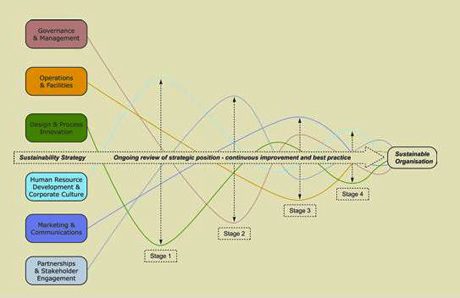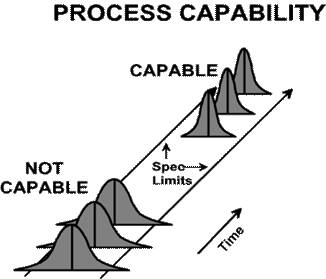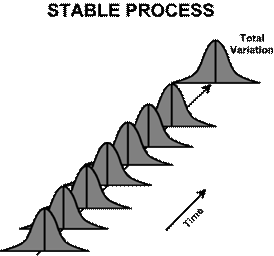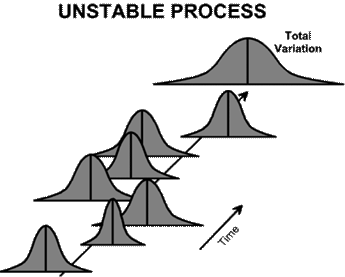
Balanced scorecard methodology is an analysis technique designed to translate an organization's mission statement and overall business strategy into specific, quantifiable goals and to monitor the organization's performance in terms of achieving these goals. Developed by Robert Kaplan and David Norton in 1992, the balanced scorecard methodology is a comprehensive approach that analyzes an organization's overall performance in four ways, based on the idea that assessing performance through financial returns only provides information about how well the organization did prior to the assessment, so that future performance can be predicted and proper actions taken to create the desired future.
The methodology examines performance in four areas: financial analysis, the most traditionally used performance indicator, includes assessments of measures such as operating costs and return-on-investment; customer analysis looks at customer satisfaction and retention; internal analysis looks at production and innovation, measuring performance in terms of maximizing profit from current products and following indicators for future productivity; and finally, learning and growth analysis explores the effectiveness of management in terms of measures of employee satisfaction and retention and information system performance.
As a structure, balanced scorecard methodology breaks broad goals down successively into vision, strategies, tactical activities, and metrics. As an example of how the methodology might work, an organization might include in its mission statement a goal of maintaining employee satisfaction. This would be the organization's vision. Strategies for achieving that vision might include approaches such as increasing employee-management communication. Tactical activities undertaken to implement the strategy could include, for example, regularly scheduled meetings with employees. Finally, metrics could include quantifications of employee suggestions or employee surveys.
Business TransformationsDisappointing results and failure to meet expectations are too often the outcome of ambitious business transformations. There are no silver bullets that guarantee that a programme will not go pear shaped but there are methods and techniques that can be applied when a business needs to move fast and the price of failure is high. This executive briefing looks at key issues that management might face in a business transformation that deploys well-established technologies to introduce a significant improvement in performance spanning multiple locations. The techniques and approaches described here are not merely theoretical speculations but real life strategies that are tried and proven.
Ambitious results can rarely, if ever, be delivered by means of new IT alone, however important technology can be as an enabler. This is because organisations are made up of people who are more complex than the machines that form one part of the total system. Business transformation therefore depends on orchestrating the various means available and focusing effort on critical issues. It is true that there are well established, engineering like disciplines that are sometimes applied to "IT" projects. In contrast the tasks of influencing behaviour, designing reward systems, modifying management processes and organisation structure are less susceptible to engineering rigour. This will be evident in every manager's experience, in that it would be unusual to find investment analysis, formal project management discipline or benefits measurement regimes that are expected for "IT projects" applied to a new performance appraisal system, a management restructuring, new job descriptions, or changes to staff skills. Yet these elements can be more significant in terms of either resources expended or strategic impact. A business transformation presumes a holistic approach that may deploy software as a vehicle for the effective orchestration of these components. This is not to say that an organisation should abandon disciplined approaches which might be characteristic of a traditional IT project. Rather the organisation must apply mature business judgement and all the combined management experience it can muster. These aspects do not naturally lend themselves to precisely definable timetables and planning -the imponderables of people's reactions are too complex and unpredictable to neatly fit an engineer's discipline. Management and control must be achieved by more subtle means. But, only by orchestrating all aspects in this way can success be made possible. For example, a business must have great sales management software, appoint and motivate people who have talent for winning new clients, establish a reward and recognition system which reinforces their effort and establish an organisational structure which releases them to pursue new clients without distraction to improve sales performance. If any of these factors is missing the effectiveness of the change will be in doubt. A business transformation budget will therefore be likely to include substantial sums for expert resources required to support the business in redesign of key processes, organisational structure and job definitions etc. That is not to usurp general management's territory but to bring to these aspects similar structure and rigour to that expected in "IT" projects and to promote sufficient coherence to seize the prizes.
Innovation & GrowthInnovation is a new way of doing something. It may refer to incremental and emergent or radical and revolutionary changes in thinking, products, processes, or organizations.
In the organizational context, innovation may be linked to performance and growth through improvements in efficiency, productivity, quality, competitive positioning, market share, etc. All organizations can innovate, including for example hospitals, universities, and local governments.
While innovation typically adds value, innovation may also have a negative or destructive effect as new developments clear away or change old organizational forms and practices. Organizations that do not innovate effectively may be destroyed by those that do. Hence innovation typically involves risk. A key challenge in innovation is maintaining a balance between process and product innovations where process innovations tend to involve a business model which may develop shareholder satisfaction through improved efficiencies while product innovations develop customer support however at the risk of costly R&D that can erode shareholder return. In summary, innovation can be described as the result of some amount of time and effort into researching (R) an idea, plus some larger amount of time and effort into developing (D) this idea, plus some very large amount of time and effort into commercializing (C) this idea into a market place with customers


The Process Capability is a measurable property of a process to the specification, expressed as a process capability index (e.g., Cpk or Cpm) or as a process performance index (e.g., Ppk or Ppm). The output of this measurement is usually illustrated by a histogram and calculations that predict how many parts will be produced out of specification.
Process capability is also defined as the capability of a process to meet its purpose as managed by an organization's management and process definition structures ISO 15504.


Two parts of process capability are: 1) Measure the variability of the output of a process, and 2) Compare that variability with a proposed specification or product tolerance.
The input of a process usually has at least one or more measurable characteristics that are used to specify outputs. These can be analyzed statistically; where the output data shows a normal distribution the process can be described by the process mean (average) and the standard deviation.
A process needs to be established with appropriate process controls in place. A control chart analysis is used to determine whether the process is "in statistical control". If the process is not in statistical control then capability has no meaning. Therefore the process capability involves only common cause variation and not special cause variation.
Predictive ModellingPredictive modelling is the process by which a model is created or chosen to try to best predict the probability of an outcome.[1] In many cases the model is chosen on the basis of detection theory to try to guess the probability of a signal given a set amount of input data, for example given an email determining how likely that it is spam.
Predictive modeling is a process used in predictive analytics to create a statistical model of future behavior. Predictive analytics is the area of data mining concerned with forecasting probabilities and trends.
A predictive model is made up of a number of predictors, which are variable factors that are likely to influence future behavior or results. In marketing, for example, a customer's gender, age, and purchase history might predict the likelihood of a future sale.
In predictive modeling, data is collected for the relevant predictors, a statistical model is formulated, predictions are made and the model is validated (or revised) as additional data becomes available. The model may employ a simple linear equation or a complex neural network, mapped out by sophisticated software.
Predictive modeling is used widely in information technology (IT).
Six SigmaSix Sigma is a systematical process of "quality improvement through the disciplined data-analyzing approach, and by improving the organizational process by eliminating the defects or the obstacles which prevents the organizations to reach the perfection".
Six sigma points out the total number of the defects that has come across in an organizational performance. Any type of defects, apart from the customer specification, is considered as the defect, according to Six Sigma. With the help of the statistical representation of the Six Sigma, it is easy to find out how a process is performing on quantitatively aspects. A Defect according to Six Sigma is nonconformity of the product or the service of an organization.
Since the fundamental aim of the Six Sigma is the application of the improvement on the specified process, through a measurement-based strategy, Six Sigma is considered as a registered service mark or the trade mark. Six Sigma has its own rules and methodologies to be applied. In order to achieve this service mark, the process should not produce defects more than 3.4. These numbers of defects are considered as "the rate of the defects in a process should not exceed beyond the rate 3.4 per million opportunities". Through the Six Sigma calculation the number of defects can be calculated. For this there is a sigma calculator, which helps in the calculation.
In order to attain the fundamental objectives of Six Sigma, there are Six Sigma methodologies to be implemented. This is done through the application of Six Sigma improvement projects, which is accomplished through the two Six Sigma sub-methodologies. Under the improvement projects came the identification, selection and ranking things according to the importance. The major two sub-divisions of the improvement projects are the Six Sigma DMAIC and the Six Sigma DMADV. These sub-divisions are considered as the processes and the execution of these processes are done through three certifications. The three types of certifications used for the execution of the Six Sigma DMAIC and Six sigma DMADV are:
"Six Sigma Green Belts and Six Sigma Black Belts, which is overseen by Six Sigma Master Black Belts".
The Six Sigma ensures the quality control, total quality management and zero defects. Through the implementation of the Six Sigma it is made sure that the goals are set on the improvement of all processes to reach the level of better quality. "The Six Sigma" shows the organization's ability of highly capable processing in producing the outputs within the limited specifications. There fore it can be said that the processes that operates with the Six Sigma quality, is able to produce a quality products at a low rate of defects.
When a process attains the certification of Six Sigma quality, it is clear that the organization has attained the standard deviations form the means of the production till the specific limitations, and so can make sure that there is no room for the items to fail to meet the specifications. Altogether we can consider the Six Sigma as the professionalizing of the quality management functions
